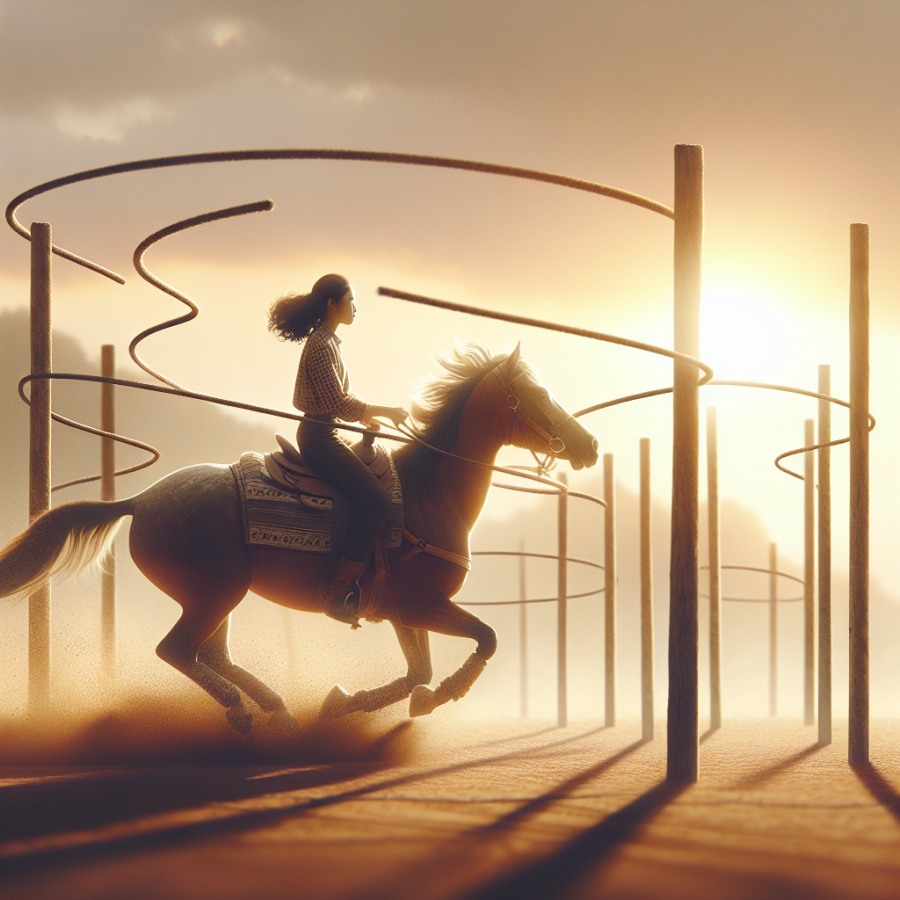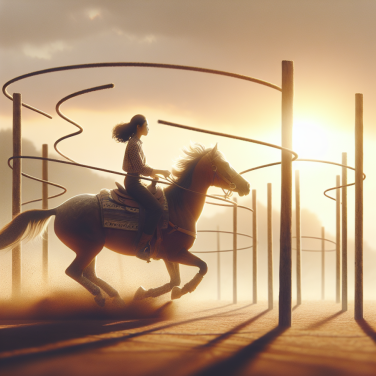Perfecting Technique: Essential Drills for Precision Pole Bending
Pole bending is a high-speed equestrian event that requires a unique combination of precision, agility, and quick reflexes. To excel in this event, riders must fine-tune their techniques through specific drills designed to enhance their performance.
Drill 1: The Weave Pattern
Start by setting up a smaller number of poles than the standard six, allowing for a focused practice session. Begin with three poles spaced 21 feet apart. The goal is to weave through the poles, focusing on maintaining a consistent pace and keeping your horse aligned with the poles. This drill teaches the horse to anticipate turns and aids in developing a rhythm that can later be transferred to a full set of poles.
Drill 2: The Serpentine Exercise
Set poles at a wider distance than usual and practice a serpentine pattern in between them. This exercise encourages flexibility and suppleness in the horse’s movement. It also helps the rider practice guiding their horse through precise maneuvers while maintaining forward momentum, crucial for achieving the best times in competition.
Drill 3: The One-Pole Practice
Isolate a single pole and work on executing a perfect 360-degree turn around it. Focus on tight, controlled turns while preventing your horse from overshooting or knocking the pole. This drill reinforces the importance of balance and precise cues from the rider, which are critical during the rapid direction changes in pole bending.
Drill 4: The Speed Control Drill
Integrate speed variations within your pole bending practice. Approach the poles at a slower pace, then gradually increase your speed with each successive run. This drill teaches speed control and helps your horse understand that it must be ready to adjust its pace as instructed by the rider, an important aspect of the acceleration and deceleration phases in a pole bending pattern.
Drill 5: The Accuracy Clinic
Place markers on the ground where precision turns should occur during a standard pole bending pattern. Practice by aiming to hit these markers accurately with each run. This not only builds a horse’s awareness of spatial placement but also ingrains accuracy into the rider’s muscle memory.
Incorporating these drills into your regular training schedule can dramatically improve your pole bending skills. Consistent practice of these exercises will lead to enhanced precision, speed, and overall performance in the arena, ultimately perfecting the techniques required for successful pole bending.
Read also:
Clash of Sticks: High-Stakes Lacrosse Showdown Thriller
Building Momentum: Strategies for Increasing Speed in Pole Bending Competitions
Pole bending is an exhilarating event that challenges both horse and rider to navigate a serpentine path around six poles arranged in a line. The goal is to complete the pattern as quickly as possible without knocking any poles over. Success in pole bending is often a balance of precision and speed, and building momentum can be crucial for a top performance. Below are strategies to help competitors increase their speed and maintain a flowing momentum throughout the course.
**Understanding the Pattern:** Before attempting to increase speed, it's essential to know the pattern by heart. Ensure the rider and horse are familiar with each turn and can navigate the poles with confidence. This understanding allows for a more fluid execution, which is critical for building momentum.
**Training for Agility:** Agility is paramount in pole bending. Incorporate pole work, cones, and other exercises into your training regiment that encourage flexibility, quick direction changes, and balance. These exercises will help your horse become more limber, enabling sharper turns and more precise movements at higher speeds.
**Building Trust and Communication:** A strong bond and clear communication between horse and rider can significantly improve performance. The rider must be able to guide the horse subtly and effectively, and the horse must trust the rider's commands. Achieving this level of understanding takes time but is essential for smooth transitions and quick responses during competition.
**Improving Rider’s Body Position:** Rider position is critical when picking up speed in pole bending. A rider should be poised and balanced, leaning into turns just enough to cue the horse without throwing off its balance. Work on maintaining a strong, flexible core and understanding how shifts in your weight influence your horse's movement.
**Horse Conditioning:** A conditioned horse is a faster horse. Conditioning improves muscle strength, cardiorespiratory endurance, and overall performance levels. Develop a conditioning programme that gradually builds your horse's stamina and speed. A fit horse will be able to maintain a faster pace for the duration of the pattern without tiring.
**Focused Practice Runs:** Regularly practice the pole bending pattern at varying speeds. Begin at a comfortable pace to ensure accuracy, and then gradually increase speed as both rider and horse become more confident. Pay attention to the areas where you're losing time and work on refining those parts of the course.
**Analyzing and Improving Turns:** The turns around the poles are where most time is either gained or lost. Work on perfecting your approach, turn, and exit at each pole.




